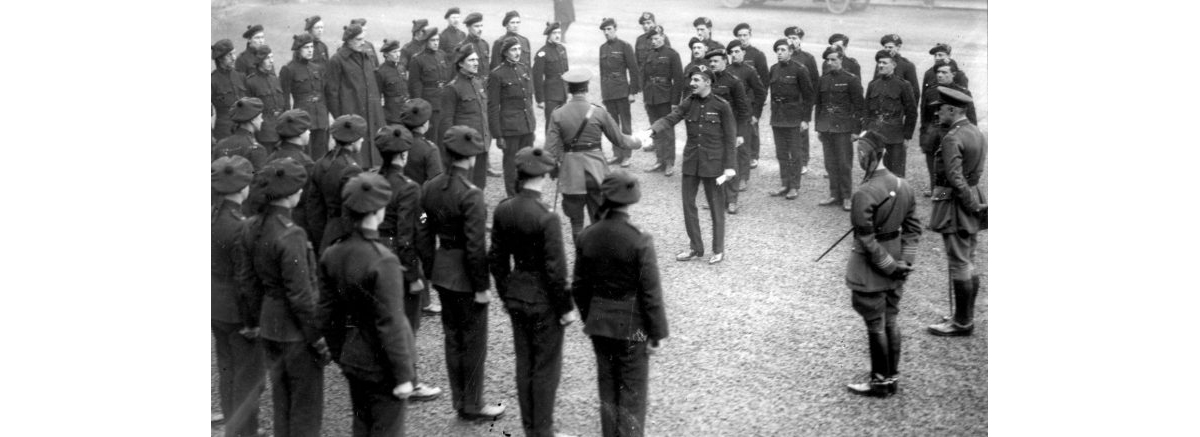
Dr Shaun McDaid
British and Irish politics
British and Irish politics expert Dr Shaun McDaid examines the Irish governments u-turn on its proposed commemoration of the role of the Royal Irish Constabulary in its Decade of Centenaries series of anniversaries and argues the issue of commemoration is inextricably linked to contemporary politics.
By Dr Shaun McDaid
“In 2012, Ireland entered a “decade of centenaries”, which would see, in quick succession, the marking of 100 year anniversaries of key events that were crucial to the history of both Ireland and Northern Ireland.
Such centenaries included the formation of the Ulster Volunteers, who vowed to oppose Home Rule for Ireland by force, the participation of Irish soldiers (from both traditions) in World War One, and, more recently, the 1916 rebellion.
Broadly speaking, although the Democratic Unionist Party of Northern Ireland boycotted the official 1916 ceremony in Dublin, the commemoration of these events has been regarded as a success, with few major controversies surrounding them… until now.
The latter part of the decade of centenaries will see the focus shift to arguably even more challenging issues, such as how to commemorate the war of independence (1919-21), the partition of the island (1920), and the Irish civil war (1922-23).
Recently, the Irish government sought to hold a state commemoration for those who served in the Royal Irish Constabulary (RIC), who lost their lives during the War of Independence. The RIC was the police force for all of Ireland (excluding Dublin, which had its own metropolitan force), and played a central role in fighting the Irish Republican Army who sought separation from Britain.
The RIC was, for the most part, comprised of Irishmen, who reflected the communities they served. However, as the War of Independence progressed, the RIC had serious issues maintaining its manpower. The RIC, as the security apparatus of the British state, had been systematically targeted by the Irish Republican Army (IRA), and many of its members left the force or were intimidated out of it.
_________________________________________________________________________
Read more: 'Template for Peace: Northern Ireland, 1972-75' - book by Dr Shaun McDaid
_________________________________________________________________________
As a result of the manpower crisis, the British government took a decision to augment the force with recruits from throughout Great Britain (although some of these were also Irish). When the new recruits, largely drawn from those who had seen service in World War One, arrived in Ireland, a uniform shortage meant they had to be clothed in a combination of army khaki and dark green jackets (which looked black). This earned them the sobriquet “the Black and Tans”.
Contrary to popular belief, the “Black and Tans” were not a separate force from the RIC, but an integral part of it. They were later supplemented, however, by a temporary group, the Auxiliary Division of the RIC, drawn from ex-officers in the Army, Navy and Air Force who were not assigned to particular counties, but deployed where it was deemed there was most need for them. The Auxiliaries didn’t have a uniform per se, and the terms “Black and Tans” and “Auxiliaries” were sometimes (inaccurately) used interchangeably.
As I pointed out in a recent letter published in The Irish Times, Sir Hamar Greenwood, formerly Chief Secretary for Ireland, in a written answer to a parliamentary question from Neville Chamberlain in February 1921, noted the differences between both cohorts:
“As I have previously explained, the so-called Black-and-Tans are not a separate force, but are recruits to the permanent establishment of the Royal Irish Constabulary. The Auxiliary Division is also a part of the Royal Irish Constabulary, but consists altogether of ex-officers of the Army, Navy or Air Force who have been recruited for temporary service only.” (House of Commons, 25 February 1921, vol. 138, c1307W).
The Black and Tans and especially the Auxiliaries have earned places of notoriety in Irish history. The former being heavily involved in the sacking of Balbriggan in County Dublin, and the latter in the burning of Cork City during 1920. Their legacy continues to provoke controversy to this day, which is why the proposed commemoration has caused so much debate. Following consistent pressure and public outcry, the Minister for Justice, Charles Flanagan, has postponed the planned ceremony indefinitely.
Proponents of the commemoration have claimed that it was meant to acknowledge the service of the “ordinary Irishmen” who served in the RIC in difficult circumstances, and not by any means the Black and Tans or Auxiliaries. Opponents stress that it is difficult, if not impossible, to compartmentalise the differing elements that made up the institution of the RIC, and query whether it is appropriate for the state to memorialise the force in an official capacity.
The debate about the RIC has also, for some, raised the question of how the unionist tradition could be accommodated if there was to be a united Ireland. Some say that the reaction to the planned event shows that the Irish state is not ready for reconciliation, and that unionists would feel unwelcome in an all-Ireland state.
_______________________________________________________________________________________________________________
Read more: 'Radicalisation and Counter-Radicalisation in Higher Education' - book by Dr Shaun McDaid and Dr Catherine McGlynn
_______________________________________________________________________________________________________________
Others suggest that this argument lends the RIC a place in northern unionist culture and heritage that it never actually enjoyed, and that, in fact, it was not wildly popular in that part of the world in its heyday.
What the above debate demonstrates is twofold. Firstly, that historical accuracy is crucial to any honest debate about the past. Scholars of Politics and History cannot afford to take a back seat in such often highly emotive debates, or there is a real risk that myths will go unchallenged.
And secondly, we can see that the issue of commemoration is inextricably linked to contemporary politics. In societies overcoming the legacy of ethnic conflict, the process is even more apparent and fraught. Ultimately, such memorialisation may have more to do with the present – and the future – than the past.”
History
Browse all our blogs related to History.
Politics
Browse all our blogs related to Politics.

